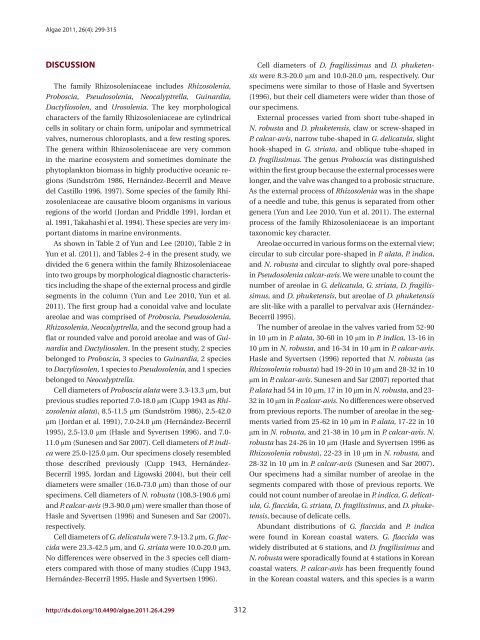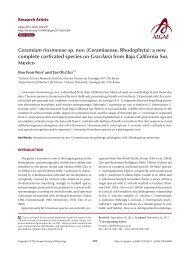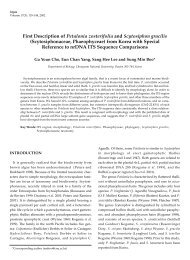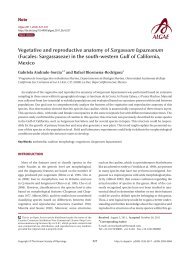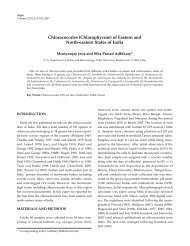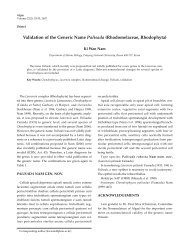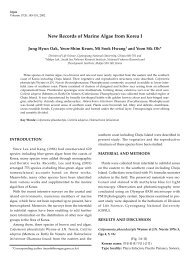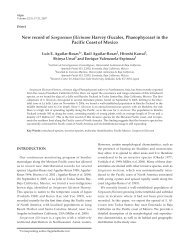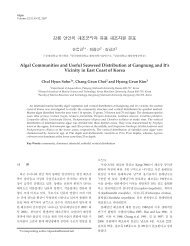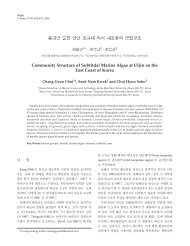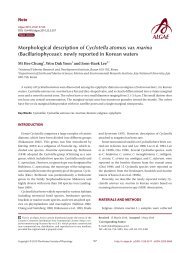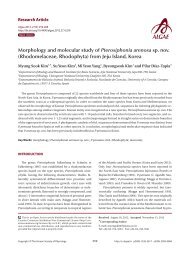Morphology and distribution of some marine diatoms, family ... - Algae
Morphology and distribution of some marine diatoms, family ... - Algae
Morphology and distribution of some marine diatoms, family ... - Algae
Create successful ePaper yourself
Turn your PDF publications into a flip-book with our unique Google optimized e-Paper software.
<strong>Algae</strong> 2011, 26(4): 299-315<br />
DISCUSSION<br />
The <strong>family</strong> Rhizosoleniaceae includes Rhizosolenia,<br />
Proboscia, Pseudosolenia, Neocalyptrella, Guinardia,<br />
Dactyliosolen, <strong>and</strong> Urosolenia. The key morphological<br />
characters <strong>of</strong> the <strong>family</strong> Rhizosoleniaceae are cylindrical<br />
cells in solitary or chain form, unipolar <strong>and</strong> symmetrical<br />
valves, numerous chloroplasts, <strong>and</strong> a few resting spores.<br />
The genera within Rhizosoleniaceae are very common<br />
in the <strong>marine</strong> ecosystem <strong>and</strong> <strong>some</strong>times dominate the<br />
phytoplankton biomass in highly productive oceanic regions<br />
(Sundström 1986, Hernández-Becerril <strong>and</strong> Meave<br />
del Castillo 1996, 1997). Some species <strong>of</strong> the <strong>family</strong> Rhizosoleniaceae<br />
are causative bloom organisms in various<br />
regions <strong>of</strong> the world (Jordan <strong>and</strong> Priddle 1991, Jordan et<br />
al. 1991, Takahashi et al. 1994). These species are very important<br />
<strong>diatoms</strong> in <strong>marine</strong> environments.<br />
As shown in Table 2 <strong>of</strong> Yun <strong>and</strong> Lee (2010), Table 2 in<br />
Yun et al. (2011), <strong>and</strong> Tables 2-4 in the present study, we<br />
divided the 6 genera within the <strong>family</strong> Rhizosoleniaceae<br />
into two groups by morphological diagnostic characteristics<br />
including the shape <strong>of</strong> the external process <strong>and</strong> girdle<br />
segments in the column (Yun <strong>and</strong> Lee 2010, Yun et al.<br />
2011). The first group had a conoidal valve <strong>and</strong> loculate<br />
areolae <strong>and</strong> was comprised <strong>of</strong> Proboscia, Pseudosolenia,<br />
Rhizosolenia, Neocalyptrella, <strong>and</strong> the second group had a<br />
flat or rounded valve <strong>and</strong> poroid areolae <strong>and</strong> was <strong>of</strong> Guinardia<br />
<strong>and</strong> Dactyliosolen. In the present study, 2 species<br />
belonged to Proboscia, 3 species to Guinardia, 2 species<br />
to Dactyliosolen, 1 species to Pseudosolenia, <strong>and</strong> 1 species<br />
belonged to Neocalyptrella.<br />
Cell diameters <strong>of</strong> Proboscia alata were 3.3-13.3 μm, but<br />
previous studies reported 7.0-18.0 μm (Cupp 1943 as Rhizosolenia<br />
alata), 8.5-11.5 μm (Sundström 1986), 2.5-42.0<br />
μm (Jordan et al. 1991), 7.0-24.0 μm (Hernández-Becerril<br />
1995), 2.5-13.0 μm (Hasle <strong>and</strong> Syvertsen 1996), <strong>and</strong> 7.0-<br />
11.0 μm (Sunesen <strong>and</strong> Sar 2007). Cell diameters <strong>of</strong> P. indica<br />
were 25.0-125.0 μm. Our specimens closely resembled<br />
those described previously (Cupp 1943, Hernández-<br />
Becerril 1995, Jordan <strong>and</strong> Ligowski 2004), but their cell<br />
diameters were smaller (16.0-73.0 μm) than those <strong>of</strong> our<br />
specimens. Cell diameters <strong>of</strong> N. robusta (108.3-190.6 μm)<br />
<strong>and</strong> P. calcar-avis (9.3-90.0 μm) were smaller than those <strong>of</strong><br />
Hasle <strong>and</strong> Syvertsen (1996) <strong>and</strong> Sunesen <strong>and</strong> Sar (2007),<br />
respectively.<br />
Cell diameters <strong>of</strong> G. delicatula were 7.9-13.2 μm, G. flaccida<br />
were 23.3-42.5 μm, <strong>and</strong> G. striata were 10.0-20.0 μm.<br />
No differences were observed in the 3 species cell diameters<br />
compared with those <strong>of</strong> many studies (Cupp 1943,<br />
Hernández-Becerril 1995, Hasle <strong>and</strong> Syvertsen 1996).<br />
http://dx.doi.org/10.4490/algae.2011.26.4.299 312<br />
Cell diameters <strong>of</strong> D. fragilissimus <strong>and</strong> D. phuketensis<br />
were 8.3-20.0 μm <strong>and</strong> 10.0-20.0 μm, respectively. Our<br />
specimens were similar to those <strong>of</strong> Hasle <strong>and</strong> Syvertsen<br />
(1996), but their cell diameters were wider than those <strong>of</strong><br />
our specimens.<br />
External processes varied from short tube-shaped in<br />
N. robusta <strong>and</strong> D. phuketensis, claw or screw-shaped in<br />
P. calcar-avis, narrow tube-shaped in G. delicatula, slight<br />
hook-shaped in G. striata, <strong>and</strong> oblique tube-shaped in<br />
D. fragilissimus. The genus Proboscia was distinguished<br />
within the first group because the external processes were<br />
longer, <strong>and</strong> the valve was changed to a probosic structure.<br />
As the external process <strong>of</strong> Rhizosolenia was in the shape<br />
<strong>of</strong> a needle <strong>and</strong> tube, this genus is separated from other<br />
genera (Yun <strong>and</strong> Lee 2010, Yun et al. 2011). The external<br />
process <strong>of</strong> the <strong>family</strong> Rhizosoleniaceae is an important<br />
taxonomic key character.<br />
Areolae occurred in various forms on the external view;<br />
circular to sub circular pore-shaped in P. alata, P. indica,<br />
<strong>and</strong> N. robusta <strong>and</strong> circular to slightly oval pore-shaped<br />
in Pseudosolenia calcar-avis. We were unable to count the<br />
number <strong>of</strong> areolae in G. delicatula, G. striata, D. fragilissimus,<br />
<strong>and</strong> D. phuketensis, but areolae <strong>of</strong> D. phuketensis<br />
are slit-like with a parallel to pervalvar axis (Hernández-<br />
Becerril 1995).<br />
The number <strong>of</strong> areolae in the valves varied from 52-90<br />
in 10 μm in P. alata, 30-60 in 10 μm in P. indica, 13-16 in<br />
10 μm in N. robusta, <strong>and</strong> 16-34 in 10 μm in P. calcar-avis.<br />
Hasle <strong>and</strong> Syvertsen (1996) reported that N. robusta (as<br />
Rhizosolenia robusta) had 19-20 in 10 μm <strong>and</strong> 28-32 in 10<br />
μm in P. calcar-avis. Sunesen <strong>and</strong> Sar (2007) reported that<br />
P. alata had 54 in 10 μm, 17 in 10 μm in N. robusta, <strong>and</strong> 23-<br />
32 in 10 μm in P. calcar-avis. No differences were observed<br />
from previous reports. The number <strong>of</strong> areolae in the segments<br />
varied from 25-62 in 10 μm in P. alata, 17-22 in 10<br />
μm in N. robusta, <strong>and</strong> 21-38 in 10 μm in P. calcar-avis. N.<br />
robusta has 24-26 in 10 μm (Hasle <strong>and</strong> Syvertsen 1996 as<br />
Rhizosolenia robusta), 22-23 in 10 μm in N. robusta, <strong>and</strong><br />
28-32 in 10 μm in P. calcar-avis (Sunesen <strong>and</strong> Sar 2007).<br />
Our specimens had a similar number <strong>of</strong> areolae in the<br />
segments compared with those <strong>of</strong> previous reports. We<br />
could not count number <strong>of</strong> areolae in P. indica, G. delicatula,<br />
G. flaccida, G. striata, D. fragilissimus, <strong>and</strong> D. phuketensis,<br />
because <strong>of</strong> delicate cells.<br />
Abundant <strong>distribution</strong>s <strong>of</strong> G. flaccida <strong>and</strong> P. indica<br />
were found in Korean coastal waters. G. flaccida was<br />
widely distributed at 6 stations, <strong>and</strong> D. fragilissimus <strong>and</strong><br />
N. robusta were sporadically found at 4 stations in Korean<br />
coastal waters. P. calcar-avis has been frequently found<br />
in the Korean coastal waters, <strong>and</strong> this species is a warm


